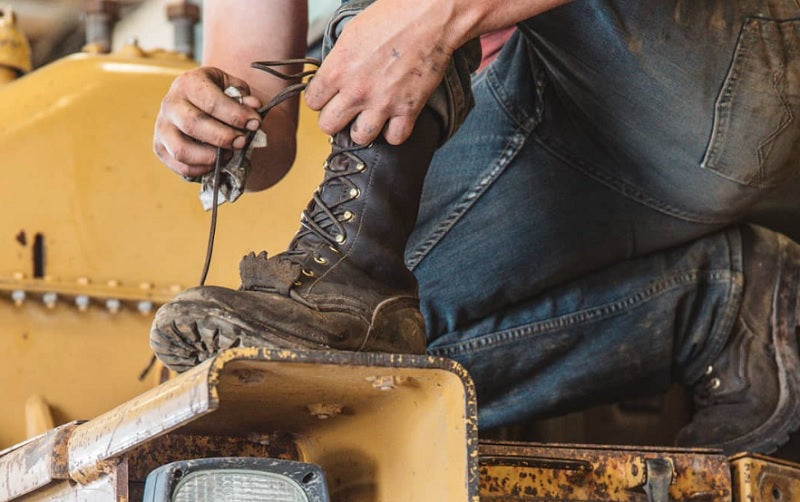There aren't any specific boots required for construction, but there are certain features that are. What kind of work boots you get are entirely up to you.
You can buy boots that technically meet the requirements at a big box "mart" store, or you can invest in a quality pair of leather work boots that will last longer and be more comfortable.
Also, be aware that there's what OSHA - the Occupational Safety and Health Administration - requires in footwear, and there's what your employer requires...and your employer may be a little more hard-nosed.
So let's talk about what boots are required for construction.
OSHA Construction Boots
OSHA actually has fairly little to say about construction boots specifically, but does lay out a guideline for working footwear. OSHA standard 1910.136 states:
"The employer shall ensure that each affected employee uses protective footwear when working in areas where there is a danger of foot injuries due to falling or rolling objects, or objects piercing the sole, or when the use of protective footwear will protect the affected employee from an electrical hazard, such as a static-discharge or electric-shock hazard, that remains after the employer takes other necessary protective measures."
So what does that mean in plain English?
Which work boots are required - or rather, the safety features that are required - depends on what kind of construction you're doing. If there's no risk of falling or rolling heavy objects, a steel toe is not required. If there is, a safety toe is required.
If you don't work around electricity, shock-proof boots are not required. If you do, they are.
If you don't have to worry about nails, screws or anything else poking through the sole, you don't have to worry about a boot that's rated for puncture resistance. If you do, then you have to get them.
That's all that the federal government has to say. Basically, you need to wear protective equipment (including work boots) that keep you safe (or safer, rather) from the specific risks that you face on your specific job site.
What Your Employer Requires For Construction Boots Is Something Else
OSHA's rule just says employers have to require safety equipment for employees; what employers deem to satisfy those requirements is something else, and not all have the same outlook on everything.
Some employers require steel or safety-toe boots regardless. Some require all boots to have Vibram or lug-style soles to reduce the risk of slips and falls. A lot of companies don't allow pull-on work boots on their job sites because they've noticed a higher rate of accidents or injuries related to footwear when employees have worn pull-on boots.
So while OSHA regulations are one thing, it's the bosses who determine how those regulations apply to their employees. So what does this mean for you?
Start with what your company requires for work boots on their job sites. There should be a policy in your company handbook, or someone you can talk to that will tell you. That's the best starting point.
From there, you start looking at what's available from bootmakers.
Invest In Quality Construction Boots
Construction keeps you on your feet all day, putting in some very hard work. You need work boots that are going to give you the support and comfort you need to not be miserable doing it. You also need those boots to fit you as well as possible.
There are lots of different work boot designs out there, and a lot of people with a lot of different preferences. Some people like a packer or logger style boot, and others prefer something like a wedge sole boot.
Here are some features you want to look for regardless of what style of work boot you're interested in.
Look for generous support in the heel. The heel of a boot absorbs a lot of the shock of walking around. That will make a huge difference by the end of the day; a lack of heel support will beat the heck out of your feet.
You need good traction in the sole. A lug sole isn't your only choice here, but you need more than a cowboy boot.
The boot needs to have the correct arch profile for your feet. If your feet have too little support in the arch - or too much structure, depending on what kind of arch support you need - it will make your feet sore, can interfere with the natural function of the foot and lead to lower leg issues.
The forefoot needs to have enough room to flex and push off at the ball of the foot. Too narrow a toe box constricts the foot and doesn't let it do what it naturally does...and pinches, which is annoying.
It also helps to get into a pair of boots that are made to last. That way, you'll get a lot more out of your investment.





































